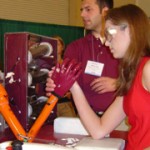Archive for Март, 2005
A Force Reflected Exoskeleton-Type Masterarm for Human–Robot Interaction
- Тип контента: Научная статья
- Номер документа: 6605
- Название документа: A Force Reflected Exoskeleton-Type Masterarm for Human–Robot Interaction
- Номер (DOI, IBSN, Патент): 10.1109/TSMCA.2004.832836
- Изобретатель/автор: Yoon Sang Kim, Jangwook Lee, Sooyong Lee, Munsang Kim
- Правопреемник/учебное заведение: University of Texas at Austin
- Дата публикации документа: 2005-03-10
- Страна опубликовавшая документ: США
- Язык документа: Английский
- Наименование изделия: Не заполнено
- Источник: IEEE TRANSACTIONS ON SYSTEMS, MAN, AND CYBERNETICS—PART A: S
- Вложения: Да
- Аналитик: Глаголева Елена
 Two human–robot interactions, including a haptic in-teraction and a teleoperated interaction, are explored in this paper with a new exoskeleton-type master-arm, in which the electric brakes with the torque sensor beams are used for force reflection. In the hap-tic interaction with virtual environment, the masterarm is used as a haptic device and tested to examine how the resistant torque of the electric brake for the force reflection is implemented in contact regime prior to conducting the teleoperated interaction. Two types of virtual environments, a rigid wall with high stiffness (hard contact with 10 [KN/m]) and a soft wall with low stiffness (soft contact with 0.1 [N/m]), are integrated with the masterarm for the haptic interaction. In hard contact, large force is fed back to the human operator, and makes the human operator hardly move. The electric brake with the torque sensor beam can detect the torque and its direction so that it allows free motion as well as contact motion by releasing or holding the movement of the operator. The experimental results show how the electric brake is switched from contact to free regime to allow the operator to move freely, especially when the operator intends to move toward the free regime in contact. In soft contact, the force applied to the human operator can be increased or decreased proportionally to the torque amount sensed by the torque sensor beam, thus the operator can feel the contact force proportional to the amount of the deformation during the contact. Finally, the masterarm is integrated with the humanoid robot, CENTAUR developed at Korea Institute of Science and Technology to conduct a pick-and-place task through the teleoperated in-teraction. It is examined that the CENTAUR as a slave robot can follow the movement of the operator.
Two human–robot interactions, including a haptic in-teraction and a teleoperated interaction, are explored in this paper with a new exoskeleton-type master-arm, in which the electric brakes with the torque sensor beams are used for force reflection. In the hap-tic interaction with virtual environment, the masterarm is used as a haptic device and tested to examine how the resistant torque of the electric brake for the force reflection is implemented in contact regime prior to conducting the teleoperated interaction. Two types of virtual environments, a rigid wall with high stiffness (hard contact with 10 [KN/m]) and a soft wall with low stiffness (soft contact with 0.1 [N/m]), are integrated with the masterarm for the haptic interaction. In hard contact, large force is fed back to the human operator, and makes the human operator hardly move. The electric brake with the torque sensor beam can detect the torque and its direction so that it allows free motion as well as contact motion by releasing or holding the movement of the operator. The experimental results show how the electric brake is switched from contact to free regime to allow the operator to move freely, especially when the operator intends to move toward the free regime in contact. In soft contact, the force applied to the human operator can be increased or decreased proportionally to the torque amount sensed by the torque sensor beam, thus the operator can feel the contact force proportional to the amount of the deformation during the contact. Finally, the masterarm is integrated with the humanoid robot, CENTAUR developed at Korea Institute of Science and Technology to conduct a pick-and-place task through the teleoperated in-teraction. It is examined that the CENTAUR as a slave robot can follow the movement of the operator.
Категория: Научные статьи | Нет комментариев »
Девушка уложила трёх роботов голыми руками
- Тип контента: Новостная статья
- Номер документа: 2246
- Название документа: Девушка уложила трёх роботов голыми руками
- Номер (DOI, IBSN, Патент): Не заполнено
- Изобретатель/автор: Не заполнено
- Правопреемник/учебное заведение: Не заполнено
- Дата публикации документа: 2005-03-09
- Страна опубликовавшая документ: Россия
- Язык документа: Русский
- Наименование изделия: Не заполнено
- Источник: http://www.membrana.ru/particle/2905
- Вложения: Не заполнено
- Аналитик: Ридна Украина)))
 Ура, в первом в мире состязании по армрестлингу между людьми и роботами человек победил машину. Человечество представляла 17-летняя девушка из Сан-Диего по имени Панна Фелсен (Panna Felsen). Для того, чтобы завалить три автоматизированные руки, ей понадобились считанные секунды.
Ура, в первом в мире состязании по армрестлингу между людьми и роботами человек победил машину. Человечество представляла 17-летняя девушка из Сан-Диего по имени Панна Фелсен (Panna Felsen). Для того, чтобы завалить три автоматизированные руки, ей понадобились считанные секунды.
Категория: Двигатели | Нет комментариев »
Wearable action-assist device, and method and program for controlling wearable action-assist device
- Тип контента: Патент
- Номер документа: 4928
- Название документа: Wearable action-assist device, and method and program for controlling wearable action-assist device
- Номер (DOI, IBSN, Патент): WO2005018525
- Изобретатель/автор: Sankai, Y.
- Правопреемник/учебное заведение: Не заполнено
- Дата публикации документа: 2005-03-03
- Страна опубликовавшая документ: Япония
- Язык документа: Японский
- Наименование изделия: Не заполнено
- Источник: http://www.wipo.int/patentscope/search/en/WO2005018525
- Вложения: Да
- Аналитик: Дмитрий Соловьев
 (EN)A wearable action-assist device for assisting the wearer to act or doing an action for the wearer (1) comprises an action-assist wearable tool (2) having an actuator (201) to give the wearer a mechanical force, a biosignal sensor (221) for detecting a biosignal of the wearer (1), a biosignal processing means (3) for obtaining, from the biosignal (a) detected by the biosignal sensor, a neurotransmitting signal (b) to move the musculoskeletal system of the wearer (1) and a muscle potential signal (c) generated when a muscle activity occurs , a voluntary control means (4) for generating, using the obtained neurotransmitting signal (b) and muscle potential signal (c), a command signal (d) to generate a mechanical force reflecting the intention of the wearer (1) in the actuator (201), and a drive current generating means (5) for producing, according to the command signal (d), currents corresponding to the neurotransmission signal (b) and the muscle potential signal (c) respectively and supplying them to the actuator (201).
(EN)A wearable action-assist device for assisting the wearer to act or doing an action for the wearer (1) comprises an action-assist wearable tool (2) having an actuator (201) to give the wearer a mechanical force, a biosignal sensor (221) for detecting a biosignal of the wearer (1), a biosignal processing means (3) for obtaining, from the biosignal (a) detected by the biosignal sensor, a neurotransmitting signal (b) to move the musculoskeletal system of the wearer (1) and a muscle potential signal (c) generated when a muscle activity occurs , a voluntary control means (4) for generating, using the obtained neurotransmitting signal (b) and muscle potential signal (c), a command signal (d) to generate a mechanical force reflecting the intention of the wearer (1) in the actuator (201), and a drive current generating means (5) for producing, according to the command signal (d), currents corresponding to the neurotransmission signal (b) and the muscle potential signal (c) respectively and supplying them to the actuator (201).
(FR)Cette invention se rapporte à un dispositif portatif d’assistance aux mouvements, servant à assister dans ces mouvements la personne qui le porte, appelée utilisateur, ou à effectuer un mouvement pour l’utilisateur (1) et comprenant à cet effet un instrument portatif (2) d’assistance aux mouvements, comportant un actuateur (201) destiné à conférer à l’utilisateur une force mécanique, un capteur de biosignal (221) servant à détecter un biosignal de l’utilisateur (1), un processeur de biosignal (3) destiné à obtenir, à partir du biosignal (a) détecté par le capteur de biosignal, un signal neurotransmetteur (b) destiné à déplacer le système musculo-squelettique de l’utilisateur (1) et un signal de potentiel musculaire (c) généré lorsqu’une activité musculaire se produit, un moyen de commande volontaire (4) destiné à produire, en utilisant le signal neurotransmetteur (b) et le signal de potentiel musculaire (c) obtenus, un signal d’instruction (d) destiné à générer une force mécanique reflétant les intentions de l’utilisateur (1) dans l’actuateur (201), et un générateur de courant d’excitation (5) destiné à produire, en fonction du signal d’instruction (d), des courants correspondant au signal neurotransmetteur (b) et au signal de potentiel musculaire (c) respectivement et à appliquer ces signaux à l’actuateur (201).
(JA) 装着者の動作を補助あるいは代行する装着式動作補助装置は、装着者1に対して動力を付与するアクチュエータ201を有した動作補助装着具2と、装着者1の生体信号を検出する生体信号センサ221と、装着者1の筋骨格系を動作させるための神経伝達信号bおよび筋活動に伴う筋電位信号cを、生体信号センサにより検出された生体信号aから取得する生体信号処理手段3と、生体信号処理手段3により取得された神経伝達信号bおよび筋電位信号cを用い、装着者1の意思に従った動力をアクチュエータ201に発生させるための指令信号dを生成する随意的制御手段4と、随意的制御手段4により生成された指令信号dに基づいて、神経伝達信号bに応じた電流および筋電位信号cに応じた電流をそれぞれ生成し、アクチュエータ201に供給する駆動電流生成手段5とを備える。
Категория: Патенты | Нет комментариев »
Motion Capture to the People: A High Quality, Low Budget Approach to Real Time Motion Capture
- Тип контента: Научная статья
- Номер документа: 7468
- Название документа: Motion Capture to the People: A High Quality, Low Budget Approach to Real Time Motion Capture
- Номер (DOI, IBSN, Патент): Не заполнено
- Изобретатель/автор: Daniel Saidi, Magnus Åsard
- Правопреемник/учебное заведение: Department of Science and Technology Linköping Institute of Technology Linköpings Unversitet
- Дата публикации документа: 2005-03-03
- Страна опубликовавшая документ: Швеция
- Язык документа: Английский
- Наименование изделия: Не заполнено
- Источник: Master’s Thesis in Media Technology
- Вложения: Да
- Аналитик: Глаголева Елена
 Motion Capture is currently a widely used technology for character anima-tion, and can be seen as a common ingredient of many contemporary animated feature films and video games. Compared to traditional character animation, the Motion Capture technology can quickly produce very high quality animation data with high resemblance to real life motion. Unfortunately, the technology is very expensive, and commercial systems with a price tag below $20.000 can today be considered as a bargain. Hence, using Motion Capture as a tool for incorporating high quality live motion in a low budget animation project seems impossible as of today. However, since the underlying theory and principles behind capturing live motion are relatively straightforward, it should be possible to develop a Motion Capture system without having to spend tens of thousands of dollars. This thesis presents a full body Motion Capture system developed with strictly limited resources, at a total cost of $950. The system consists of an electromechanical, exoskeletal suit, constructed with cheap and lightweight materials, and a client-server software solution capable of real time visualization and data export. This diploma work has shown that it is possible to construct a high quality, real time Motion Capture system at a considerably low cost, compared to commercial alternatives. By offering blueprints for mechanics, schematics for electronics and source code for the software solution, this project opens doors for further development by other technical institutions and hobbyists.
Motion Capture is currently a widely used technology for character anima-tion, and can be seen as a common ingredient of many contemporary animated feature films and video games. Compared to traditional character animation, the Motion Capture technology can quickly produce very high quality animation data with high resemblance to real life motion. Unfortunately, the technology is very expensive, and commercial systems with a price tag below $20.000 can today be considered as a bargain. Hence, using Motion Capture as a tool for incorporating high quality live motion in a low budget animation project seems impossible as of today. However, since the underlying theory and principles behind capturing live motion are relatively straightforward, it should be possible to develop a Motion Capture system without having to spend tens of thousands of dollars. This thesis presents a full body Motion Capture system developed with strictly limited resources, at a total cost of $950. The system consists of an electromechanical, exoskeletal suit, constructed with cheap and lightweight materials, and a client-server software solution capable of real time visualization and data export. This diploma work has shown that it is possible to construct a high quality, real time Motion Capture system at a considerably low cost, compared to commercial alternatives. By offering blueprints for mechanics, schematics for electronics and source code for the software solution, this project opens doors for further development by other technical institutions and hobbyists.
Категория: Научные статьи | Нет комментариев »
Design considerations for a wearable monitor to measure finger posture
- Тип контента: Научная статья
- Номер документа: 6288
- Название документа: Design considerations for a wearable monitor to measure finger posture
- Номер (DOI, IBSN, Патент): 10.1186/1743-0003-2-5
- Изобретатель/автор: Lisa K Simone, Derek G Kamper
- Правопреемник/учебное заведение: Rehabilitation Institute of Chicago
- Дата публикации документа: 2005-03-01
- Страна опубликовавшая документ: США
- Язык документа: Английский
- Наименование изделия: Не заполнено
- Источник: Journal of NeuroEngineering and Rehabilitation
- Вложения: Да
- Аналитик: Глаголева Елена
 Background: Objective measures of hand function as in-dividuals participate in home and community activities are needed in order to better plan and evaluate re-habilitation treatments. Traditional measures collected in the clinical setting are often not reflective of actual functional performance. Recent advances in technology, however, enable the development of a lightweight, comfortable data collection monitor to measure hand kinematics.
Background: Objective measures of hand function as in-dividuals participate in home and community activities are needed in order to better plan and evaluate re-habilitation treatments. Traditional measures collected in the clinical setting are often not reflective of actual functional performance. Recent advances in technology, however, enable the development of a lightweight, comfortable data collection monitor to measure hand kinematics.
Methods: This paper presents the design analysis of a wearable sensor glove with a specific focus on the sensors selected to measure bend. The most important requirement for the glove is easy donning and removal for individuals with significantly reduced range of motion in the hands and fingers. Additional require-ments include comfort and durability, cost effectiveness, and measurement repeatability. These require-ments eliminate existing measurement gloves from consideration. Glove construction is introduced, and the sensor selection and glove evaluation process are presented.
Results: Evaluation of commercial bend sensors shows that although most are not appropriate for repeatable measurements of finger flexion, one has been successfully identified. A case study for sensor glove repea-tability using the final glove configuration and sensors does show a high degree of repeatability in both the gripped and flat hand positions (average coefficient of variability = 2.96%and 0.10%, respectively).
Conclusion: Measuring functional outcomes in a portable manner can provide a wealth of information impor-tant to clinicians for the evaluation and treatment of movement disorders in the hand and fingers. This de-vice is an important step in that direction as both a research and an evaluation method.
Категория: Научные статьи | Нет комментариев »
Статистика
Категорий: 179
Статей всего: 2,003
По типу:
Видео: 36
Выдержка с форума: 1
Контактные данные: 12
Научная статья: 1388
Не заполнено: 5
Новостная статья: 317
Обзор технологии: 42
Патент: 219
Тех.подробности: 34
Тип: 1
Комментариев: 9,095
Изображений: 3,005
Подробней...
ТОР 10 аналитиков
-
Глаголева Елена - 591
Дмитрий Соловьев - 459
Helix - 218
Ридна Украина))) - 85
Наталья Черкасова - 81
max-orduan - 29
Елена Токай - 15
Роман Михайлов - 9
Мансур Жигануров - 4
Дуванова Татьяна - 3
Календарь
Авторизация
Ошибка в тексте?
Выдели её мышкой!
И нажми Ctrl+Enter